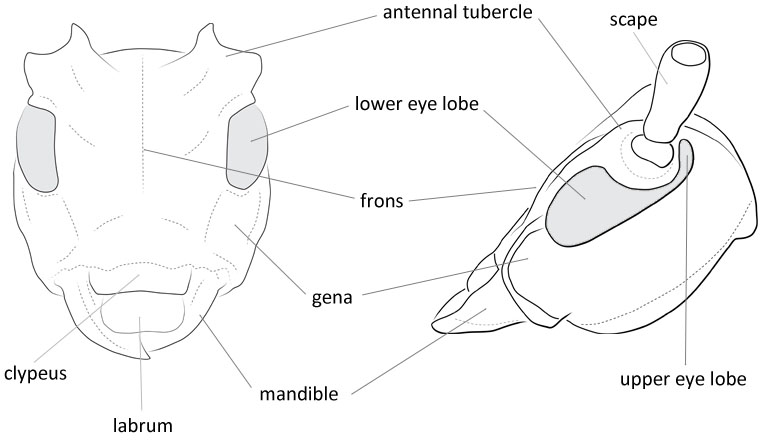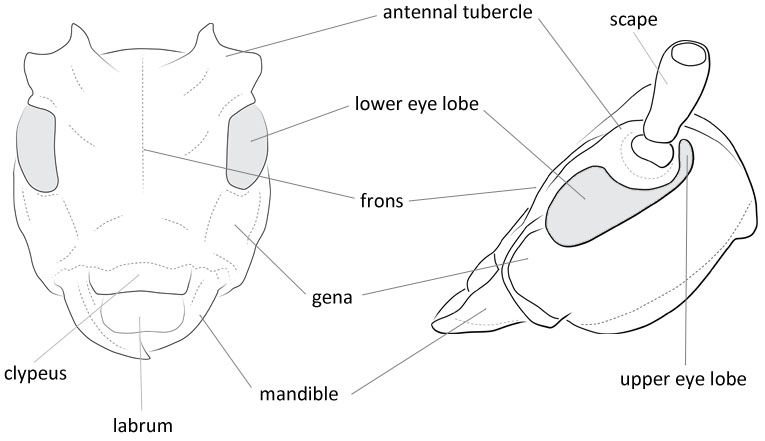Body length: 5–8 mm.
Eyes: eye interommatidial setaeseta:
a sclerotized hair-like projection of the cuticle
absent, eye deeply emarginateemarginate:
notched at the margin > half width, eye ommatidial density fine.
> half width, eye ommatidial density fine.
Antennaeantenna:
in larval and adult insects, paired segmented appendages, borne one on each side of the head, functioning as sense organs and bearing a large number of sensilla
: antennal length reaches between basebase:
the part of any appendage or structure that is nearest the body
and end of elytraelytron:
the leathery forewing of beetles, serving as a covering for the hind wings, commonly meeting opposite elytron in a straight line down the middle of the dorsum in repose
or reaching/surpassing end of body, antennal flagellar segments elongateelongate:
much longer than wide
, scapescape:
the first proximal segment of the antenna smooth/punctate at apexapex:
smooth/punctate at apexapex:
end of any structure distad to the base
, antennal scapescape:
the first proximal segment of the antenna ≥ segment 3.
≥ segment 3.
Pronotumpronotum:
the upper and dorsal part of the prothorax
: pronotumpronotum:
the upper and dorsal part of the prothorax
shape longer than wide, pronotumpronotum:
the upper and dorsal part of the prothorax
lateral armature absent.
Prosternum: prosternal processprosternal process:
a posterior extension of the prosternum between the coxae not dilated at apexapex:
not dilated at apexapex:
end of any structure distad to the base
, procoxal cavities open posteriorly, rarely closed posteriorly.
Elytraelytron:
the leathery forewing of beetles, serving as a covering for the hind wings, commonly meeting opposite elytron in a straight line down the middle of the dorsum in repose
: elytral length reaching or close to end of abdomen, elytral apicesapex:
end of any structure distad to the base
rounded or truncatetruncate:
cut off squarely at the tip
, elytral color pattern present.
Legs: visible tarsomerestarsomere:
subdivision or article of the tarsus, usually numbering from two to five : 4, femora clavateclavate:
: 4, femora clavateclavate:
thickening gradually toward the tip
, protibial spursprotibial spur:
sclerotized spine(s) located at the distal tibia; can be single, double, or absent : 2, tarsal clawstarsal claw:
: 2, tarsal clawstarsal claw:
usually paired claws of the pretarsus, at the distal end of the leg simple.
simple.
Integument dull. Head with front declivous; antennaeantenna:
in larval and adult insects, paired segmented appendages, borne one on each side of the head, functioning as sense organs and bearing a large number of sensilla
slightly longer than body in male, second segment nearly half as long as third, third segment not longer than fourth; antennal tubercles scarcely elevated, intervening area convex; clypeusclypeus:
that part of the insect head below the frons, to which the labrum is attached anteriorly with a small impression on each side at basebase:
with a small impression on each side at basebase:
the part of any appendage or structure that is nearest the body
; palpi with last segment narrowly triangular. Pronotumpronotum:
the upper and dorsal part of the prothorax
without any dorsal callosities. Elytraelytron:
the leathery forewing of beetles, serving as a covering for the hind wings, commonly meeting opposite elytron in a straight line down the middle of the dorsum in repose
with pubescentpubescent:
downy; clothed with soft, short, fine, loosely set hair
fasciae. Legs moderately short; femora very strongly clubbed; anterior tarsitarsus:
the leg segment distal to the apex of the tibia, bearing the pretarsus; consists of one to five tarsomeres (including pretarsus)
of male with first 2 segments swollen, of female slender (Linsley 1963Linsley 1963:
Linsley EG. 1963. The Cerambycidae of North America. Part IV. Taxonomy and Classification of the Subfamily Cerambycinae, Tribes Elaphidionini Through Rhinotragini. University of California Publications in Entomology, Vol. 21. 165 pp.).
Differs from Phymatodes by the second antennal segment more than twice as long as wide/about half as long as third, the final palpal segment triangularly dilated, and the male with the proleg tarsomerestarsomere:
subdivision or article of the tarsus, usually numbering from two to five 1 and 2 swollen. Differs from the Obriini by these characters and the unmodified abdomen in females.
1 and 2 swollen. Differs from the Obriini by these characters and the unmodified abdomen in females.
western Nearctic: British Columbia to California.
Pseudotsuga menziesii, Tsuga heterophylla
Monotypic. Larvae bore in small branches and adults visit flowers.
Eumichtus Lameere, 1883
Eumichthus LeConte, 1873